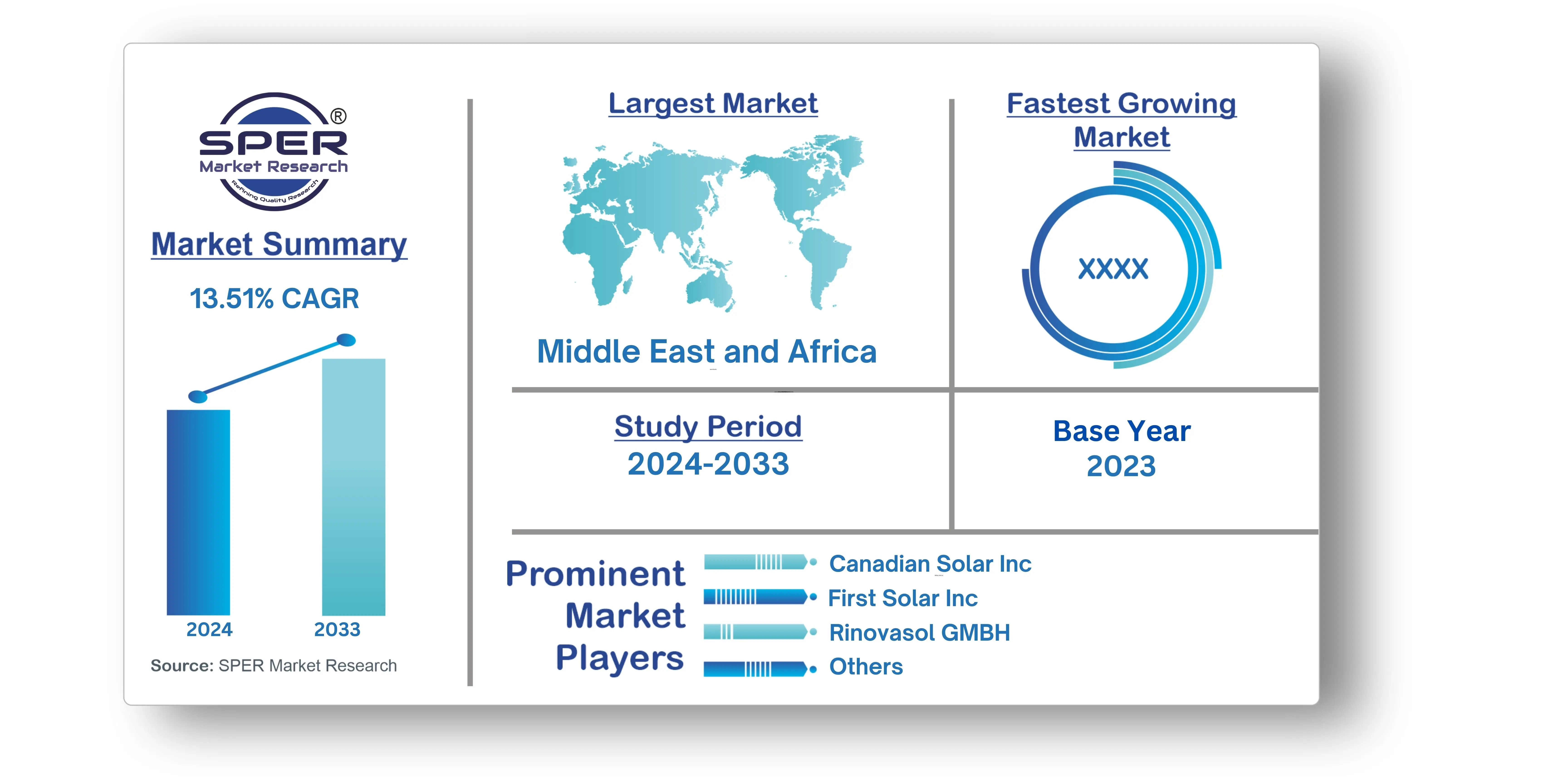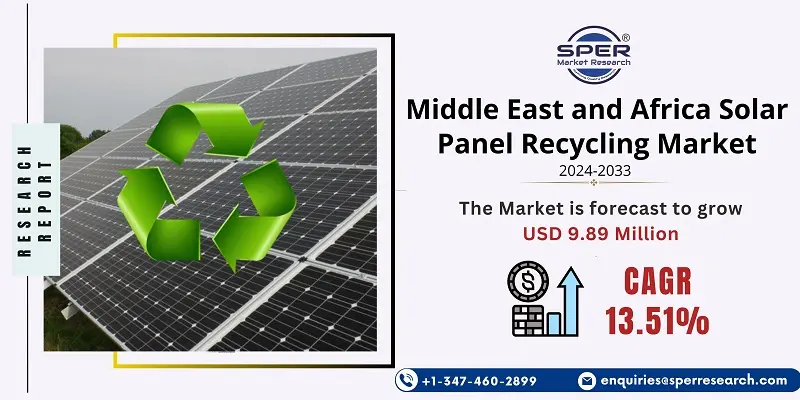
MEA Solar Panel Recycling Market Growth, Size, Trends, Share, Revenue and Future Outlook
Middle East and Africa Solar Panel Recycling Market Size- By Process, By Type- Regional Outlook, Competitive Strategies and Segment Forecast to 2033
| Published: Jul-2024 | Report ID: POAE2461 | Pages: 1 - 154 | Formats*: |
| Category : Power & Energy | |||
- In November 2022, First Solar Inc. announced plans to invest USD 1.1 billion in the development of a photovoltaic (OV) solar module manufacturing facility in Lawrence County, Alabama, which will create over 700 jobs.
- April 2021: A new research endeavour at the UNEP DTU Partnership is expected to improve the odds of collecting and recycling electronic waste from small solar PV systems in Kenya and other African countries.

- Novel Recycling Technologies: The MEA solar panel recycling industry offers prospects for the creation and uptake of novel recycling technologies. Innovative methods that can lower costs and increase recycling efficiency include robotic dismantling, automated sorting, and effective material recovery procedures.
- Partnerships and Cooperation: Working together, recyclers, government agencies, and producers of solar panels can promote the growth of a strong solar panel recycling industry. Partnerships can help with infrastructure development, knowledge sharing, and the adoption of sustainable practices.
- Value Chain Integration: Incorporating solar panel recycling into the broader solar energy value chain can result in a comprehensive and sustainable strategy. The industry may improve resource recovery and reduce waste by building effective reverse logistics systems and including recycling considerations into the design process.

| Report Metric | Details |
| Market size available for years | 2020-2033 |
| Base year considered | 2023 |
| Forecast period | 2024-2033 |
| Segments covered | By Process, By Type |
| Regions covered | South Africa, Egypt, United Arab Emirates, Rest of Middle East and Africa |
| Companies Covered | Canadian Solar Inc, First Solar Inc, Rinovasol GMBH, Sharp Corporation, SunPower Corporation, Trina Solar Ltd, Interco Trading Inc. |
- Solar Panel Manufacturers
- Solar Energy Companies
- Government and Regulatory Bodies
- Environmental Organizations
- Waste Management Companies
- Investors and Financial Institutions
- Recycling Technology Providers
- Research and Development Institutions
- Large Corporations with Solar Installations
- Residential Solar Panel Owners
| By Process: |
|
| By Type: |
|
- Middle East and Africa Solar Panel Recycling Market Size (FY’2024-FY’2033)
- Overview of Middle East and Africa Solar Panel Recycling Market
- Segmentation of Middle East and Africa Solar Panel Recycling Market by Process (Thermal, Mechanical, Chemical, Other Processes)
- Segmentation of Middle East and Africa Solar Panel Recycling Market by Type (Crystalline Silicon, Thin Film)
- Statistical Snap of Middle East and Africa Solar Panel Recycling Market
- Expansion Analysis of Middle East and Africa Solar Panel Recycling Market
- Problems and Obstacles in Middle East and Africa Solar Panel Recycling Market
- Competitive Landscape in the Middle East and Africa Solar Panel Recycling Market
- Impact of COVID-19 and Demonetization on Middle East and Africa Solar Panel Recycling Market
- Details on Current Investment in Middle East and Africa Solar Panel Recycling Market
- Competitive Analysis of Middle East and Africa Solar Panel Recycling Market
- Prominent Players in the Middle East and Africa Solar Panel Recycling Market
- SWOT Analysis of Middle East and Africa Solar Panel Recycling Market
- Middle East and Africa Solar Panel Recycling Market Future Outlook and Projections (FY’2024-FY’2033)
- Recommendations from Analyst
1.1. Scope of the report1.2. Market segment analysis
2.1. Research data source2.1.1. Secondary Data2.1.2. Primary Data2.1.3. SPER’s internal database2.1.4. Premium insight from KOL’s2.2. Market size estimation2.2.1. Top-down and Bottom-up approach2.3. Data triangulation
4.1. Driver, Restraint, Opportunity and Challenges analysis4.1.1. Drivers4.1.2. Restraints4.1.3. Opportunities4.1.4. Challenges4.2. COVID-19 Impacts of the Middle East and Africa Solar Panel Recycling Market.
5.1. SWOT Analysis5.1.1. Strengths5.1.2. Weaknesses5.1.3. Opportunities5.1.4. Threats5.2. PESTEL Analysis5.2.1. Political Landscape5.2.2. Economic Landscape5.2.3. Social Landscape5.2.4. Technological Landscape5.2.5. Environmental Landscape5.2.6. Legal Landscape5.3. PORTER’s Five Forces5.3.1. Bargaining power of suppliers5.3.2. Bargaining power of buyers5.3.3. Threat of Substitute5.3.4. Threat of new entrant5.3.5. Competitive rivalry5.4. Heat Map Analysis
6.1. Middle East and Africa Solar Panel Recycling Market Manufacturing Base Distribution, Sales Area, Product Type6.2. Mergers & Acquisitions, Partnerships, Product Launch, and Collaboration in Middle East and Africa Solar Panel Recycling Market
7.1. Middle East and Africa Solar Panel Recycling Market Size, Share and Forecast, By Process, 2020-20267.2. Middle East and Africa Solar Panel Recycling Market Size, Share and Forecast, By Process, 2027-20337.3. Thermal7.4. Mechanical7.5. Chemical7.6. Other Processes
8.1. Middle East and Africa Solar Panel Recycling Market Size, Share and Forecast, By Type, 2020-20268.2. Middle East and Africa Solar Panel Recycling Market Size, Share and Forecast, By Type, 2027-20338.3. Crystalline Silicon8.4. Thin Film
9.1. Middle East and Africa Solar Panel Recycling Market Size and Market Share
10.1. Middle East and Africa Solar Panel Recycling Market Size and Market Share By Region (2020-2026)10.2. Middle East and Africa Solar Panel Recycling Market Size and Market Share By Region (2027-2033)10.3. South Africa10.4. Egypt10.5. United Arab Emirates10.6. Rest of Middle East and Africa
11.1. Canadian Solar Inc11.1.1. Company details11.1.2. Financial outlook11.1.3. Product summary11.1.4. Recent developments11.2. First Solar Inc11.2.1. Company details11.2.2. Financial outlook11.2.3. Product summary11.2.4. Recent developments11.3. Rinovasol GMBH11.3.1. Company details11.3.2. Financial outlook11.3.3. Product summary11.3.4. Recent developments11.4. Sharp Corporation11.4.1. Company details11.4.2. Financial outlook11.4.3. Product summary11.4.4. Recent developments11.5. SunPower Corporation11.5.1. Company details11.5.2. Financial outlook11.5.3. Product summary11.5.4. Recent developments11.6. Trina Solar Ltd11.6.1. Company details11.6.2. Financial outlook11.6.3. Product summary11.6.4. Recent developments11.7. Interco Trading Inc11.7.1. Company details11.7.2. Financial outlook11.7.3. Product summary11.7.4. Recent developments11.8. Others
SPER Market Research’s methodology uses great emphasis on primary research to ensure that the market intelligence insights are up to date, reliable and accurate. Primary interviews are done with players involved in each phase of a supply chain to analyze the market forecasting. The secondary research method is used to help you fully understand how the future markets and the spending patterns look likes.
The report is based on in-depth qualitative and quantitative analysis of the Product Market. The quantitative analysis involves the application of various projection and sampling techniques. The qualitative analysis involves primary interviews, surveys, and vendor briefings. The data gathered as a result of these processes are validated through experts opinion. Our research methodology entails an ideal mixture of primary and secondary initiatives.



Frequently Asked Questions About This Report
PLACE AN ORDER
Year End Discount
Sample Report
Pre-Purchase Inquiry
NEED CUSTOMIZATION?
Request CustomizationCALL OR EMAIL US
100% Secure Payment






Related Reports
Our Global Clients
Our data-driven insights have influenced the strategy of 200+ reputed companies across the globe.






















